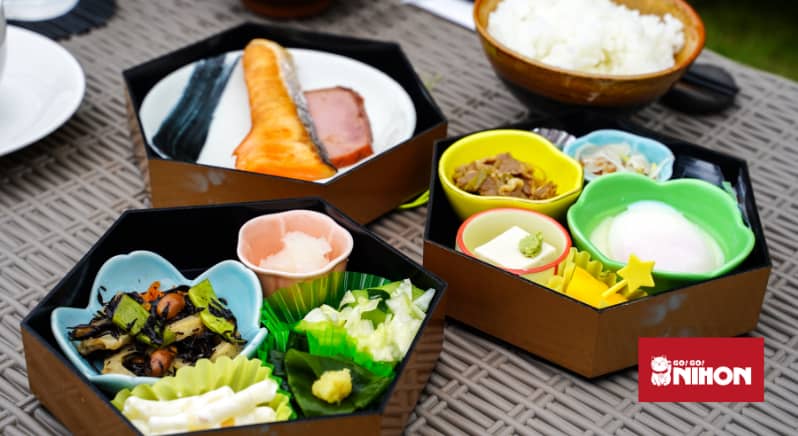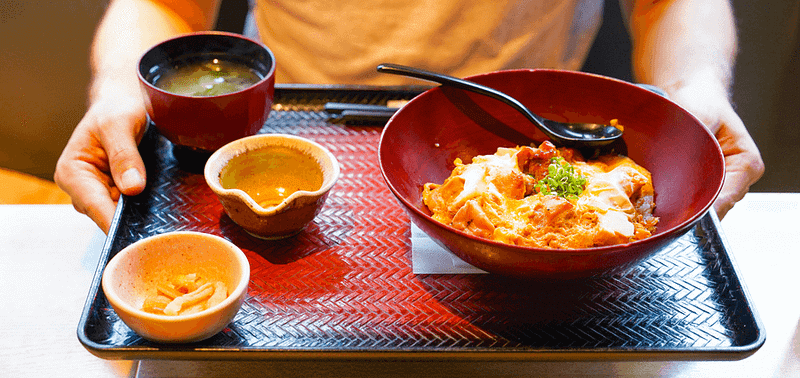Breakfast in Japan is quite different from what most people are used to, especially if you come from the western part of the world where breakfast food is very distinguished from the other meals of the day. A traditional Japanese breakfast consists of a variety of smaller dishes, and could easily be enjoyed at lunch or dinner time as well. A Japanese breakfast is very nutritious and is sure to get you properly energised for the rest of your day. Let’s take a closer look at the first meal of the day served in Japanese homes.

A traditional Japanese breakfast
Steamed rice – Rice is a staple food in Japan and is also served for breakfast. Both white rice, hakumai (白米), and brown rice, genmai (玄 米), are just as delicious, or why not a have a mix of the two types?
Miso soup – The miso soup is, just like the rice, a staple for breakfast and is made of miso and dashi. It is common to have pieces of tofu, lettuce and wakame in the soup.
Grilled fish – Grilled fish, or yakizakana (焼き魚), is a popular feature for breakfast in Japan to get that extra protein kick in the morning. Grill it in the oven or fry it in the pan, with only a little bit of oil and salt to add some flavour. Any type of fish will do, but salmon and mackerel are the most popular.
Natto – Natto (納豆) is produced by fermenting soybeans and is a very protein rich dish that is often served together with rice. Natto is very popular in Japan, but it can take some time to get used to its smell and appearance.
Tsukemono – Tsukemono (漬 物) is served not only for breakfast but for all the day’s meals and is eaten together with the rice. Tsukemono literally means “pickled things” and often consist of vegetables and fruits. A common type of tsukemono is umeboshi (梅干し), or pickled plums.
Nori – Nori (海苔) is a kind of dried and flavoured seaweed that is often sold in large leaves, almost like a sheet of paper. Nori is usually eaten together with the rice and tastes good just as it is, but it is also tasty to dip in a little bit of soy sauce.
Kobachi – Kobachi (小鉢,) are small portions of vegetables, and can be both pickles (tsukemono) or a fresh green salad. Even cooked vegetables go well with breakfast.
Tamagoyaki – Tamagoyaki (卵焼き) is a type of Japanese omelet made by rolling several layers of cooked eggs, often in a square frying pan. All Japanese families have their own recipes for tamagoyaki, but the most popular ingredients, in addition to eggs, are sugar, soy sauce, mirin and sake.
Green tea – Just as for any meal of the day, it’s perfect to finish off the breakfast with a cup of green tea.
It is quite time consuming to prepare all these little dishes every morning so it’s not very unusual to take shortcuts to speed up the process a little. For example, you can leave rice in the rice cooker overnight so that it is still hot the next morning. It’s also fairly common for Japanese to buy miso soup and natto in singe person packs, so it’s quick and easy to only pick out the exact amount you need each morning.
Even though a traditional Japanese breakfast consists of a lot of dishes, they are often small and not too heavy or fatty. However, not everyone prefers a Japanese breakfast, and it is very common for Japanese to choose a breakfast with Western elements, not only when they are in a hotel or restaurant but also in their own homes.
Western breakfast, Japanese style
The most common basic ingredient in a Western breakfast is the so-called shokupan (食パン) or “food bread”. It is a white bread, not very different from regular white toast, and is preferably cut into thick, juicy slices. It is best to toast the bread first, and to further enhance the taste, spread on some peanut butter, jam or marmalade. Shokupan is sold in all grocery stores and there is also a variety of jams and marmalades to choose from.
Whether a Japanese or Western breakfast, most people like to enjoy a cup of coffee in the morning. Coffee is not a typical Japanese drink, but it is sold everywhere and there are many different roasts and flavours to choose from.
Some Japanese eat a version of the American breakfast, complete with thick pancakes, bacon, sausage and eggs. With a small green salad or a little fruit on the side, it is perfect.
If you, just like myself, don’t want to eat rice, fried fish, American pancakes or thick slices of bread for breakfast, luckily it is not very complicated to find substitutes to the food we are used to.
- Breakfast cereal – In most grocery stores there are many different options to choose from, some we know from home but there are also a few Japanese brands. If you want something extra filling, opt for a granola variety (グラノーラ).
- Yogurt – Yogurt is usually stocked in most shops, and is good to pair with some berries and honey.
- Oatmeal and muesli – If you are looking to make some classic oat porridge, oatmeal is often found in shops specialising in foreign foods. These shops usually have slightly higher prices than regular grocery stores because much of their supply is imported. Kaldi and Seijo Ishii are two chain stores that are often located in the bigger cities.
- Cheese – Kaldi and Seijo Ishii also carries a few different types of cheese, but they are usually quite expensive and not usually the type you would like to have for breakfast. But they are sure to have some tasty soft cheese, and if you prefer the hard type cheese from up north, a trip to the Swedish furniture store IKEA might be worth your time.
Whatever you prefer to eat in the morning, you can easily find what you need to prepare a Japanese or Western style breakfast at home. Or why not go to a restaurant or coffee shop if you want some extra added luxury in the morning? If you’re curious about breakfast in Japan or Japanese traditional cuisine in general, check out our article on washoku!













